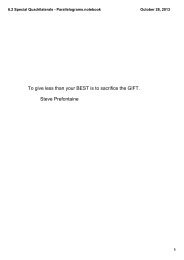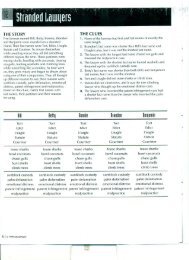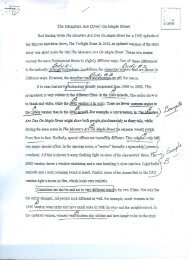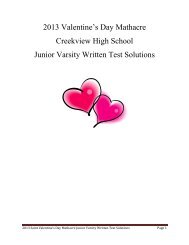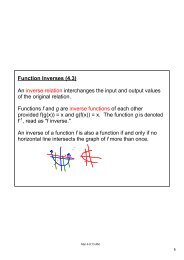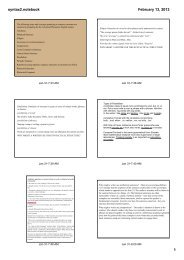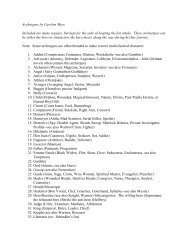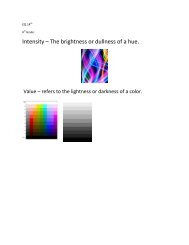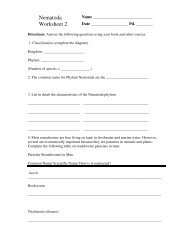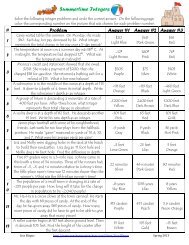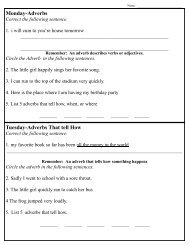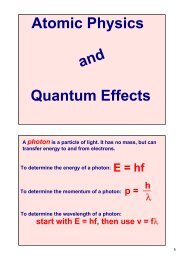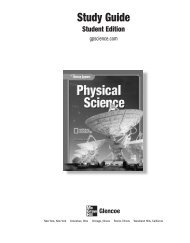Rosencrantz and Guildenstern Are Dead - Cherokee County Schools
Rosencrantz and Guildenstern Are Dead - Cherokee County Schools
Rosencrantz and Guildenstern Are Dead - Cherokee County Schools
Create successful ePaper yourself
Turn your PDF publications into a flip-book with our unique Google optimized e-Paper software.
Luigi Pir<strong>and</strong>ello's play, Six Characters in Search of an Author (1921), is another example of "a play within a<br />
play'' <strong>and</strong> the most famous literary investigation into how fictional life <strong>and</strong> real life relate to one another. As<br />
actors rehearse a play, six fictional characters from an unfinished play mount the stage <strong>and</strong> dem<strong>and</strong> to have<br />
their story represented <strong>and</strong> resolved.<br />
The Importance of Being Earnest (1895), by Oscar Wilde, is the classic example of the epigrammatic verbal<br />
wit that Stoppard is renowned for <strong>and</strong> which he first displayed so brilliantly in <strong>Rosencrantz</strong> <strong>and</strong> <strong>Guildenstern</strong><br />
<strong>Are</strong> <strong>Dead</strong>.<br />
On Death <strong>and</strong> Dying (1969) by Elisabeth Kubler-Ross is a classic investigation into the human attitudes<br />
toward death. She describes five stages of dying that move from denial, anger, bargaining, <strong>and</strong> depression to<br />
acceptance.<br />
Sigmund Freud was a provocative commentator on human attitudes toward death, <strong>and</strong> though nearly every<br />
educated person is familiar with Freud's basic ideas, few have actually read him. A very short <strong>and</strong> readable<br />
essay of astounding sensitivity called "On Transcience" (1916) is perhaps a good place to start in reading<br />
Freud.<br />
Bibliography <strong>and</strong> Further Reading<br />
Further Reading<br />
Bareham, T., editor, Tom Stoppard: <strong>Rosencrantz</strong> <strong>and</strong> <strong>Guildenstern</strong> are <strong>Dead</strong>, Jumpers, Travesties: a<br />
Casebook, Macmillan, 1990.<br />
Contains interviews with Stoppard, general assessments of his work, reviews of early productions, <strong>and</strong><br />
excerpts from critical studies.<br />
Cahn, Victor L., Beyond Absurdity: The Plays of Tom Stoppard, Associated University Presses, 1979.<br />
In a long section on <strong>Rosencrantz</strong> <strong>and</strong> <strong>Guildenstern</strong> are <strong>Dead</strong>, Cahn contrasts Stoppard's play with the<br />
traditional Theatre of the Absurd.<br />
Gordon, Robert, <strong>Rosencrantz</strong> <strong>and</strong> <strong>Guildenstern</strong> <strong>Are</strong> <strong>Dead</strong>, Jumpers, <strong>and</strong> The Real Thing: Text <strong>and</strong><br />
Performance, Macmillan, 1991.<br />
Part of a useful series that focuses on the performance aspects of plays. The sections on <strong>Rosencrantz</strong> <strong>and</strong><br />
<strong>Guildenstern</strong> <strong>Are</strong> <strong>Dead</strong> include one that describes <strong>and</strong> comments on its first professional production at the Old<br />
Vic in 1967.<br />
Harty, III, John, editor, Tom Stoppard: A Casebook, Garl<strong>and</strong>, 1988.<br />
Three essays on the play, including invaluable essays by William E. Gruber <strong>and</strong> J. Dennis Huston that discuss<br />
how Stoppard uses the Shakespearean text.<br />
Hayman, Ronald, Contemporary Playwrights: Tom Stoppard, Heinemann, 1977.<br />
A very readable critical study that includes a short chapter on Stoppard's first major play <strong>and</strong> a valuable<br />
interview with the author.<br />
Jenkins, Anthony, editor, Critical Essays on Tom Stoppard, G.K. Hall, 1990.<br />
Includes four important essays on the play <strong>and</strong> an especially valuable interview with Stoppard.<br />
Londre, Felicia Hardison, Tom Stoppard, Frederick Ungar, 1981.<br />
A scholarly assessment of Stoppard's work through the late 1970s, including a chapter on <strong>Rosencrantz</strong> <strong>and</strong><br />
<strong>Guildenstern</strong> <strong>Are</strong> <strong>Dead</strong>. Accessible for most students.<br />
What Do I Read Next? 21



